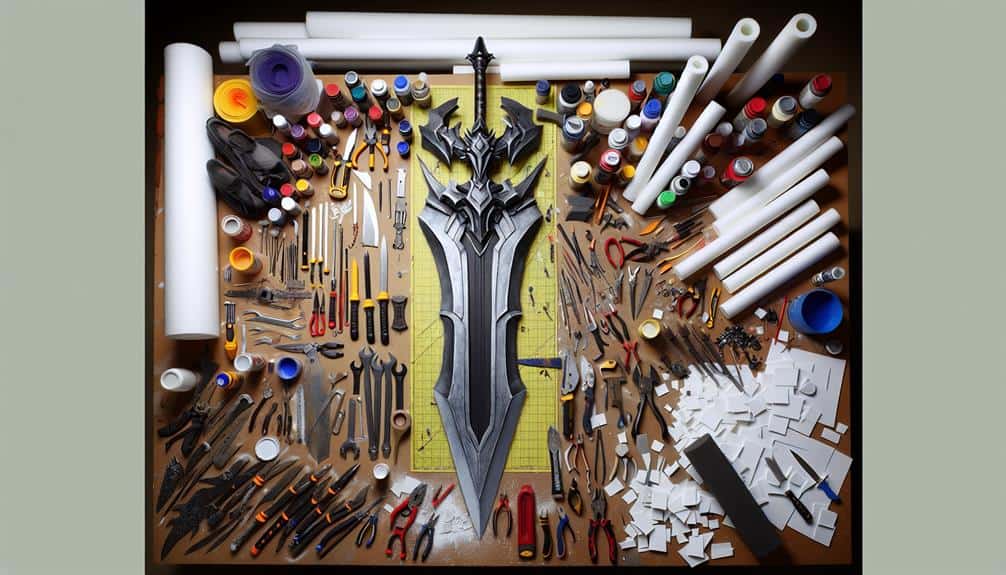Imagine this: a stunning set design that not only looks amazing but also aligns with your values.
The choice of eco-friendly materials for props goes beyond just aesthetics; it can lead to a chain reaction of positive outcomes. From reducing waste to promoting sustainability, the reasons to opt for eco-conscious prop-making practices are compelling.
So, why not explore how choosing green alternatives can elevate your creative process and make a difference?
Key Takeaways
- Reduce environmental impact and promote sustainability in prop making.
- Save costs and enhance durability with eco-friendly materials.
- Align with consumer demand for ethical production practices.
- Support positive environmental change in the cosplay community.
Benefits of Using Eco-Friendly Props
When choosing eco-friendly materials for props, you can greatly reduce environmental impact while still achieving the desired aesthetic and functionality. One of the key benefits of opting for eco-friendly props is the cost savings they offer. While some eco-friendly materials may have a slightly higher upfront cost, they often prove to be more cost-effective in the long run due to their durability and longevity. This cost-saving aspect is important for prop makers looking to maximize their budget without compromising on quality.
Additionally, by using eco-friendly materials for props, you can substantially reduce the environmental impact of your projects. Traditional prop-making materials often involve the use of harmful chemicals and non-biodegradable substances that contribute to pollution and waste. In contrast, eco-friendly materials are typically sourced sustainably, produced using renewable energy, and are biodegradable or recyclable. This shift towards eco-friendly props not only benefits the environment but also aligns with the growing consumer demand for sustainable and ethical production practices.
Sustainable Options for Prop Making
Sustainable prop making offers diverse environmentally-friendly materials and techniques to minimize ecological impact in the production process. When sourcing materials, opt for sustainable options such as reclaimed wood, bamboo, cork, or recycled metals. These materials aren't only eco-friendly but also durable and versatile for prop making. Look for suppliers who prioritize sustainable sourcing and ethical production practices, ensuring that your props aren't only environmentally responsible but also ethically produced.
Consider using natural fibers like organic cotton, hemp, or linen for fabric-based props. These materials have a lower environmental footprint compared to synthetic fabrics and are biodegradable. Additionally, explore biodegradable alternatives to traditional plastics for prop elements requiring durability. Materials like bioplastic, which decomposes naturally, can be a sustainable choice for creating props that need to withstand wear and tear.
Impact of Eco-Friendly Materials
To understand the true impact of eco-friendly materials in prop making, it's essential to rethink their environmental benefits and long-term sustainability. When considering the environmental impact, eco-friendly materials greatly reduce carbon footprint and minimize waste generation compared to traditional materials. Ethical sourcing plays an important role in ensuring that the materials used are obtained in a sustainable and socially responsible manner. By opting for eco-friendly materials, you contribute to positive environmental change by supporting practices that prioritize the well-being of the planet and its inhabitants.
The use of eco-friendly materials in prop making not only benefits the environment but also sets a standard for ethical sourcing within the industry. These materials often come from renewable sources, helping to conserve natural resources and reduce the overall impact on ecosystems. Additionally, promoting ethical sourcing practices through the adoption of eco-friendly materials encourages transparency and accountability throughout the supply chain. Making informed choices about the materials you use in prop making can lead to a more sustainable and responsible approach that aligns with your values as a conscientious creator.
Eco-Conscious Practices in Cosplay
Considering the growing emphasis on environmental impact, incorporating eco-conscious practices in cosplay becomes an important aspect for creators seeking to align their craft with sustainable principles. Ethical sourcing of materials is a key component of eco-conscious cosplay. Opting for fabrics and accessories that are ethically sourced safeguards that no human rights violations or environmental harm occurred during the production process.
Additionally, waste reduction is a fundamental practice in eco-conscious cosplay. By carefully planning projects to minimize excess materials, repurposing items, and recycling whenever possible, cosplayers can notably reduce their environmental footprint. Embracing a waste reduction mindset can lead to innovative solutions, such as upcycling old costumes or using biodegradable materials for props.
Ultimately, integrating ethical sourcing and waste reduction practices into cosplay not only promotes sustainability but also sets a positive example for the community. Adopting these eco-conscious habits can inspire others to follow suit, collectively contributing to a more environmentally friendly cosplay culture.
Choosing Green Alternatives for Props
When selecting props for your cosplay creations, prioritize environmentally friendly materials to reduce your carbon footprint and contribute to a more sustainable cosplay community. Opting for green alternatives not only benefits the environment but also enhances the overall quality of your props. Sustainable solutions like using biodegradable materials such as bamboo, cork, or recycled fabrics can greatly reduce the environmental impact of your cosplay endeavors. These materials not only decompose naturally, reducing landfill waste, but also require fewer resources to produce compared to traditional synthetic materials.
In addition to biodegradable options, consider utilizing materials that are easily recyclable or upcycled. For instance, repurposing old cardboard, paper, or metal into props not only gives these items a new life but also minimizes the need for new raw materials. By incorporating these eco-friendly practices into your prop-making process, you can play a crucial role in fostering a more sustainable cosplay community while still creating stunning and authentic props for your costumes.
Frequently Asked Questions
Are There Any Disadvantages to Using Eco-Friendly Materials for Props?
Using eco-friendly materials for props may have some drawbacks. Cost efficiency can be a challenge due to higher initial prices. Aesthetics may vary. Availability of specific eco-friendly options might be limited. However, the positive environmental impact outweighs these concerns.
How Can I Ensure the Eco-Friendly Props I Choose Are Durable and Long-Lasting?
To guarantee durability in your eco-friendly props, concentrate on sustainable production methods and material choice. Opt for high-quality, long-lasting materials like bamboo or recycled plastics. The environmental impact is minimized, and your props will stand the test of time.
What Are Some Unique Ways to Incorporate Eco-Friendly Materials Into Prop Making?
Explore prop making through innovative upcycling techniques. Unveil your creativity by blending sustainable sourcing with ethical production. Infuse designs with eco-friendly allure. Embrace unique ways to craft props that captivate while honoring the planet.
Are There Any Specific Certifications or Labels to Look for When Choosing Eco-Friendly Props?
Look for credible green certifications like FSC, OEKO-TEX, or USDA Organic when choosing eco-friendly props. Make sure material sourcing is sustainable and production processes have minimal environmental impact. These certifications validate eco-friendly claims and practices.
How Can I Dispose of Eco-Friendly Props Responsibly at the End of Their Life Cycle?
When it's time to bid farewell to your eco-friendly props, explore recycling options to give them a new life. Consider upcycling ideas to transform them into something fresh. Composting solutions and waste management strategies can also be beneficial.



